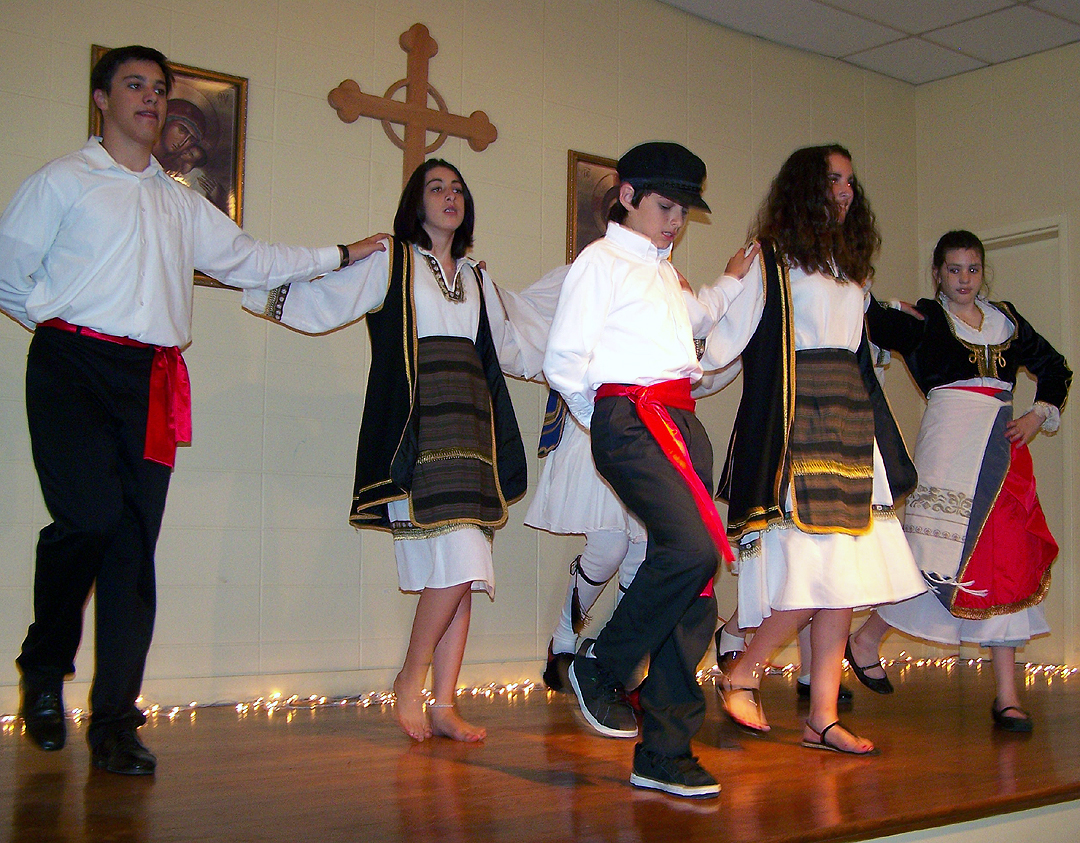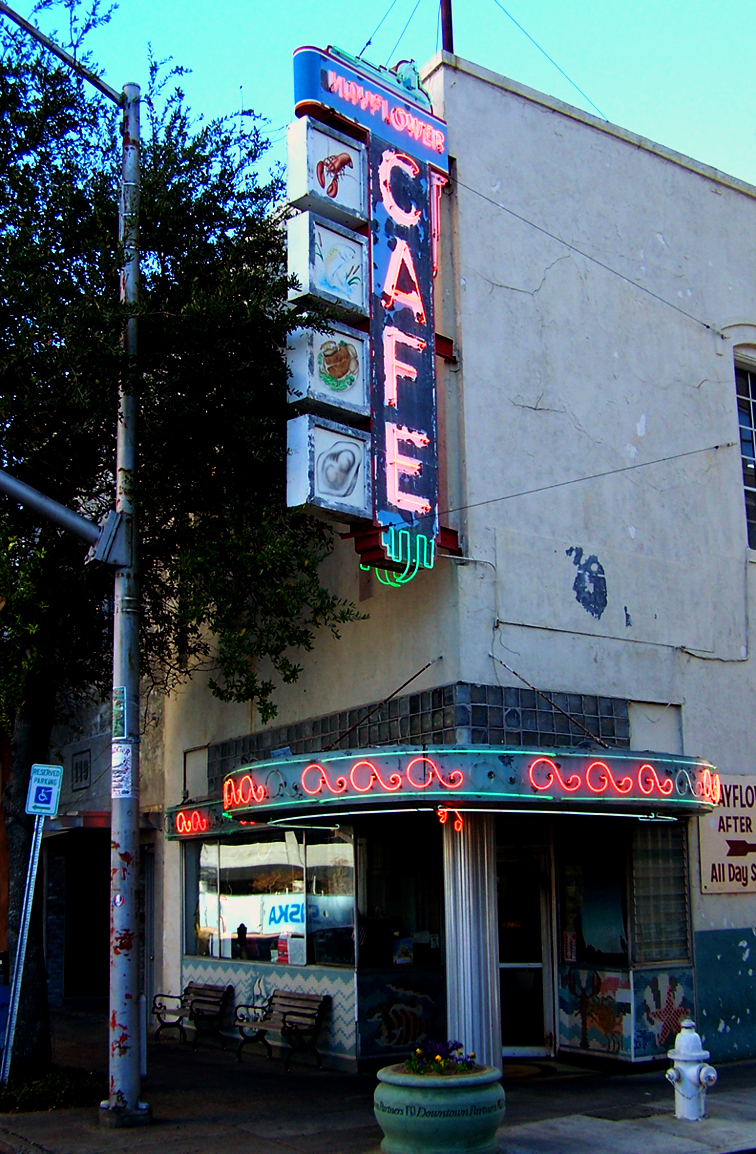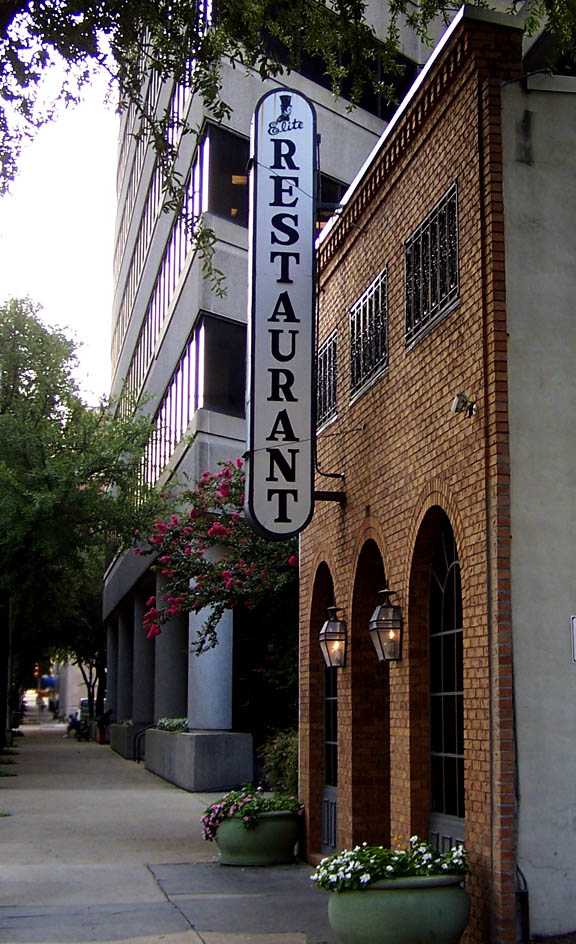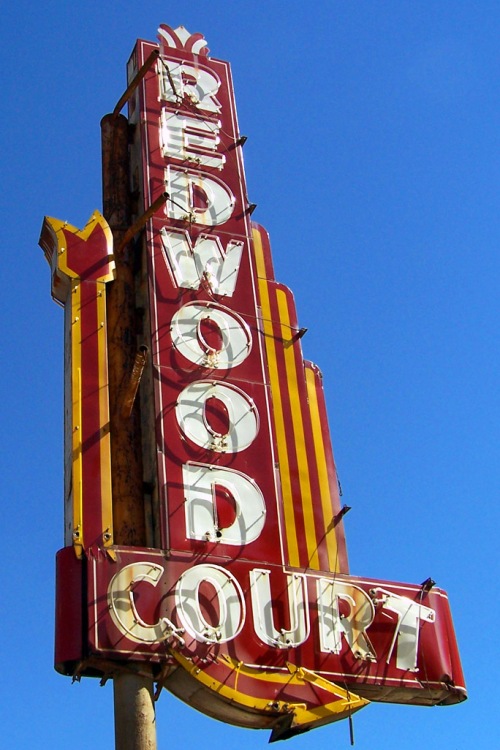Jackson’s Greek Community: A Profile
Originally published in 2009, this article remains one of the few substantial accounts of our Greek neighbors, who both as individuals and as a community have vastly enriched this city.
With the fascinating exception of Tarpon Springs, Florida, where an old country industry found new life, most Greek immigrants settled in the northeast. But according to Ellen Hontzas, most of the immediate ancestors of Jackson’s families were from the South.

“I was born here, but my daddy Anthony Tattis was from Mobile,” Ellen says. “He was in the Air Force, stationed here, and I was born at the air base (now Hawkins Field). I lived in what was called the ‘GI village’, on Avalon, but most of the other Greeks lived in west and south Jackson. Just about everything we did centered on the church.”
Indeed, the Greek Orthodox Church makes up the heart of the community. Dr. Virginia Cora, a member for over forty years, says, “The church and its calendar provide structure for the changing of seasons; these traditions may be less strictly observed now, but still are important.”
The Rev. Fr. Christopher Harner, presiding priest at Holy Trinity & St. John the Theologian at 1417 West Capitol Street, says, “It’s intriguing to note that this parish, the reason it is double-named is because the members of the original founding group were never able to agree on one common name. Normally, if a parish is double-named, it is because there was a split in the community that was healed and both sides came together. This parish is somewhat unique in that it started with groups of people who were not able to agree on a particular name.”

“I grew up in New York with a father from Greece and an American mother,” says Laura (Stamatakis) Orr. “I got the best of both worlds. They raised me in a large Greek community, but when I was young my family moved to California to an even bigger Greek community. I even had my own big fat Greek wedding in a Greek Orthodox cathedral in Los Angeles.”
“My husband and I decided to move here to Mississippi, where he is from, about 2 years ago, Laura says. “It was a very difficult choice, leaving my parents, my friends and my church, but we now enjoy a special yet different experience, a small community that welcomed us with open arms, one that was built by the first families that arrived in this part of the South.”
“The family includes nuclear and extended family both here and in the old country, as well as church family,” Virginia Cora says. “Any occasion calls for a gathering, especially birth days or name days, Easter and Epiphany.”
Virginia says that she, her friends and family savor life in the moment. “We do love to eat, dance, and celebrate the occasion, any occasion. Feast days usually have favored foods associated with them, certain breads like tsoureki for Easter and Christopomo for Christmas, vasilopita for New Year, and pitas or cookies for other holidays.” Virginia says that meals including appetizers, entrées, and desserts are consumed casually over several hours. The music tends to be traditional folk music with dancing and sing-a-longs like syrtaki, hassapiko and tsimako. Drink includes beers and wines consumed with meals and in moderation, especially retsina (resinated white wine), kokkineli, Metaxa and ouzo.


Kanellos Katsaboulas, proprietor of Kat’s Wine Cellar, says, “My father did own a restaurant, Christos’ Deli, but that was more of a side hobby that he had. His primary business was Katsaboulas Tile and Marble, which was in operation for over 35 years.”
“It’s a real close community. My brother (Tasho) and I both grew up in the Greek church, went to Greek school. My father was Greek, my mother was from Mississippi, and we grew up with both influences. Having my Geek grandmother living with us was wonderful. She barely spoke English, but she cooked for us every night and involved us in the culture. We called her ‘Yama’. She came from the Peloponnese, and she and her husband moved here in the 30s. My father, Carnellas Katsaboulas, was born here, but his two brothers were born in Greece.”
“All these Greek families that I grew up knowing were very close; I called everybody ‘uncle’. That was the biggest difference between me and the other kids I grew up with. My wife is from here, but I don’t see that element in her family; she has her family, and everybody else is friend or acquaintance, but in the Greek community, you grew up not really distinguishing between who is a blood relative and who isn’t. There was really no difference in the level of respect we held for them.”
“The Jackson community is characterized by devotion to family, culture and church,” Virginia says. “The members are concerned about the welfare of their family and the success of their work. Our people are passionate about their politics, participate in elections and work with community leaders.”
“We have a good name,” Ellen says.
Sylvia’s
Jesse Houston: Chef on the Half Shell
We had a little oyster bar at Parlor Market. That’s how I met Craig Noone; we worked at an oyster bar in Stephan Pyles’ flagship, so with the tiny oyster bar in Parlor Market I got to see how Jackson feels about seafood and oysters. That planted a seed, and when I was leaving City Grocery in Oxford, I decided that Jackson would be a good spot for an oyster bar.
Since the oyster bar is the heart of Saltine, we keep the rest of the menu very seafood-centric, and being in the South, we keep the menu Southern-rooted. Then again being who I am, I like to keep things fresh and creative, to push the envelope. It’s a challenge with this concept because being in Jackson I think we get a little more of the old school mentality here towards Southern seafood, whereas at the Parlor Market, even though it was very much Southern-rooted, it was from the get-go known as a place where you could go and get an off-the-cuff creative meal. Here there’s a bit of resistance to that, so catfish, po’boys, the oysters, the wood-fired oysters, the redfish on the half shell are our top-selling dishes. The more creative dishes are harder to sell. We have an Asian influence in the calamari dishes, which is an ode to Paul Qui, who I got the opportunity to work with while I was at culinary school at the Le Cordon Bleu in Austin. He does a Brussels sprouts dish he’s very famous for that has the same kind of sauce with herbs, mint, cilantro and cabbage. The oysters Lafitte I would say is the most New Orleans-style dish we have, and we put that together while on a trip to Lafitte, Louisiana to fish for redfish, using what we had around us. 
This summer when we opened the oyster market was very bad. It certainly wasn’t the prime season for Gulf oysters by any means, and due to different regulations in Louisiana that seek to control the quality of oysters, the only ones that could leave the state were those harvested on refrigerated boats. The oysters go straight from the water into refrigeration and from those boats into a refrigerated facility or on a refrigerated truck to Jackson. That’s a huge expense. There aren’t a lot of people who do that, so we had many customers who were upset because we didn’t have Gulf oysters. When we opened, our oysters were sourced from Virginia other places on the east coast. They were very inconsistent in size, people only wanted the big ones, so it was a struggle. But as the temperatures went down, the oysters have become more available, and we no longer have that issue. We have them coming in literally every single day. I probably get anywhere from eight to twelve sacks of Gulf oysters a day, almost a thousand oysters that we go through, and we get probably another twelve to eighteen hundred from other parts of the country: the Pacific Northwest, Virginia, Massachusetts, New York, all over.
Almost all oysters these days are farm-raised, but oysters out of out of the Gulf are still wild. Even though most of the wild oysters along the east coast were eradicated back in the 1800s, and they introduced new species, some of which were invasive and killed off the native populations, you can still get wild oysters from the Gulf. I’ve heard of some great oyster farm programs in the Gulf as well. Derek Emerson was sharing some great stuff with me the other day; he and Chris Hastings were talking about these oysters off Dauphin Island that are grown in baskets that tumble in the surf, which give the oysters a great shape and salinity, and have almost no mud or dirt because they aren’t on the bottom. The other day a supplier out of Birmingham offered me some oysters called “Bama Beauties”. They were sold out at the time, and they were expensive; they were (my cost) a dollar an oyster, and I’d have to be selling them at almost $3.50, the same price I’d ask for a really high-end Pacific oyster. More gourmet Gulf oysters are starting to pop up, but the challenge will be getting people who are used to $1 or $1.50 oysters from Mississippi or Alabama to buy them.
I never considered opening anywhere but Fondren. This is where I spend all of my free time; this is where my friends seem to gather, where I run into people I love. I thought with all the other great restaurants, we could create a wonderful restaurant scene here. Of course, there already was, but I wanted to jump into the middle of it. Duling Hall wasn’t my first choice, though when I first moved to Jackson, before the Parlor Market opened, Craig took us to Duling Hall, and I walked over to the space that is now Joan Hawkins Interiors and 
I put this restaurant in the hipster capitol of Jackson, and I anticipated my friends and younger people, but I have more of an older demographic. It’s really mixed. I do get some people from out-of-town due to the great articles in “Southern Living” and “Garden & Guns”, but for the most part it’s really different from my expectations. I’ve thought about how the restaurant will evolve a lot. Things are still up in the air as we try to keep the house packed and discover what will drive people in to build our lunch business and early weekend business. The craft beers have really picked up more than I thought it would before we opened. It was always going to be a bar that focused on craft beers. We have thirty-one draughts. At first wine and cocktails were ahead in the mix, but soon the craft beers began outselling them. So we’re pushing that envelope and advocating the craft beer scene in Mississippi, which has growth spurts as well as growing pains.
The creative food is where I feed myself, it’s what I enjoy doing and why I love being a chef, but I have to ask myself if it’s right for here. Whereas I used to be able to put anything I wanted in front of people at Parlor Market, people would try it because it sounded interesting and love it and embrace it, that’s a struggle here. It’s a learning curve on the floor and in the kitchen, and though because of the long hours I work it feels like I’ve been here for five years already, we’ve only been open for six months. I have to keep reminding myself that.

Lou LaRose: Chef at Work
I’ve always enjoyed cooking and helping my mom or grandmom in the kitchen, whether it was making fried chicken or chocolate chip cookies or even tater tots. You’re still cooking. I got a job at the original Poet’s when I was really young, and it kind of went from there. I worked there for a couple of years and moved up quickly. It was pretty tough on somebody as young as I was; it was a bar scene. Obviously I felt there was more appeal to things other than washing dishes. I started bussing tables after washing dishes, then found out I was pretty good with a knife; I picked a knife up and started hacking on chicken, prepping it, trimming it, doing shrimp, and I got pretty fast at it, so that’s how I moved up into prep. I waited tables for a while, cooked, bar backed, did a little bit of everything.
When I first started cooking, I didn’t realize you could buy knives out of a catalog, I didn’t realize there were “chefs”. I mean, I did, because I remember watching “Yan Can Cook” as a kid on television and loving that dude because he was awesome. I also watched “The Galloping Gourmet”. While I was working, I was learning. When I was at Poet’s, I didn’t know you had culinary schools and real knives, so I started to learn and pick up on it and began thinking I should learn what I could at one place and then move on to another. So I progressed through the restaurants around here and ended up at Bravo!.
I started out as a hot line cook my first night there and soon picked up a lot of shifts because I was always the guy who wanted to work more. I was always one of those guys out there working. I worked at Brick Oven for a while, because a guy I worked with at Bravo! worked there as well, and he told me they were short-handed and needed some help. I picked up a few morning shifts at Brick Oven while working nights at Bravo!. I didn’t work at Brick Oven too long because I wanted to devote myself more to Bravo!. I really enjoyed working in the Bravo! kitchen; its well-run, well-organized, and I got to learn a lot of things that I’d never had my hands on before, whether it was making pizzas or baking bread. I started doing things such as that right off the bat. After about the first year I was there, I was making the breads three mornings a week. It was when I went to work at Bravo! that I began to think my career path was leading to the restaurant business.
After a couple of years, I started looking at the culinary schools. I chose Johnson & Wales in North Miami. I knew I had to go to a place to work and earn income because I couldn’t go on full scholarship, I couldn’t go with all the money in the world, and I was going to have to get loans. I went through an advanced-standing program, which let me test in and get on with recommendations for having prior experience. By this point, which was 1997, I’d worked for five or six years in kitchens, so I was able to CLEP-out of the lesser classes, since they had a program for people with industry experience. This advanced program only required me to be there about a year and a half, but it was still a full culinary degree. I went every day, early morning to mid-afternoon, and then went to work at night. I worked at some really good places there. I worked at Mark’s Las Olas for Mark Militello, who was one of the bigger-named chefs in that area when I was there.
I’m a native to Jackson. I grew up here; my dad’s been a realtor here for almost forty years. I grew up on Whitworth Street, and have lived on Belhaven, Manship and Poplar Streets. I love the Belhaven neighborhood, the old houses, the feel of it, and it’s one of the most storied neighborhoods around as well. There’s a lot of appeal to that. I chose Jackson for my restaurant because there are simply more people here who would decide to go out to eat than there would be in a more remote location such as Madison, Ridgeland or Flowood. It’s a tougher sell outside of Jackson. For one thing, you don’t get the draw from outside people in Madison or other places that you do here in the city. Not as many people go out, and you just get your local crowd, but from what I’ve seen people from those areas are more inclined to come into Jackson to eat and then go back home.
When we first came in to this location, we liked the space and we liked the way it looked at night. I really liked the old black-and-white checkerboard floors, which are still here. We kept the ceiling grid, cleaned it and repainted it. I came in and had an idea about what I wanted, how I wanted it laid out, talked to my architects about it, and we ended up gutting the whole place, took it down to four walls. The only wall that was left standing was a four-foot section that had the electrical panels on it. Everything else is brand new.
I really didn’t put a lot of thought into the menu before we opened. I wrote a menu a long time ago and just sat on it. I had a couple of different ideas for what I wanted to do, and depending on the spot I got, I was going to do a different concept. If I’d gotten the place in Madison I was looking at, it would have been completely different. You don’t want to open up something too similar to something else; I wouldn’t open up a wood-fired kitchen here with my buddy Alex Eaton at The Manship up the street, even though I worked with the pizza oven at Bravo! and worked with one at Brick Oven. I wanted to incorporate that somewhere, but it would have been at a whole different end of the culinary spectrum: less of the Creole/French/American that I’m partial to as well, and more to the Mediterranean/Spanish/Italian. That may be one day or not, you never know. I’m content right here with this one place, trying to keep the doors open, keeping the business going and building a good name and reputation as these other chefs and restauranteurs are doing.
The dynamics of restaurants in big cities change a lot more than it does in Jackson, but I like it better here because a lot of restaurants have been around for a long time, which is my interest. You know, in a lot of these cities you have restaurants that change what they do and open up for a couple of years, then they’re happy closing down and opening up another restaurant. But I look at restaurants like Bravo! and Walker’s that have been around for twenty years or longer, and that’s where I want to be. Obviously you progress with the times and you change so you stay relevant. If you can. I don’t want to be one of those restaurants that are open for five or six years and then closes down and does something different. That’s really not what I want to do. The industry is a marathon, not a sprint. The work itself is a double marathon, but it is what it is. I want Lou’s Full-Serv in Belhaven to be relevant for more than a just few years. At the end of the day, what matters is treating customers right and putting a good, well-seasoned plate in front of them that they enjoy and want to come back for. That’s really as simple as it is.








